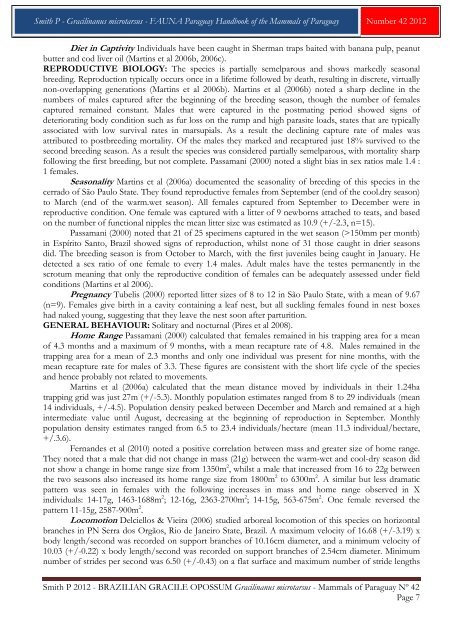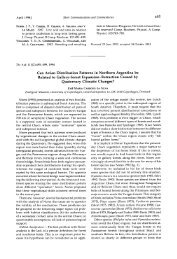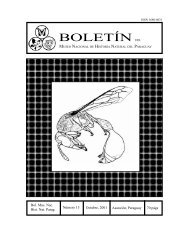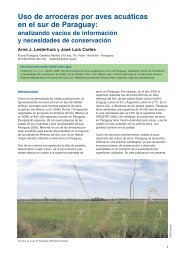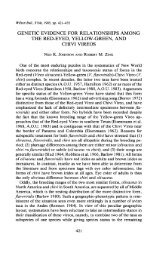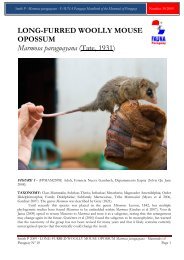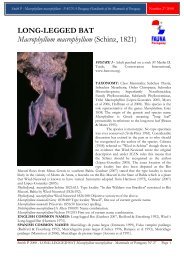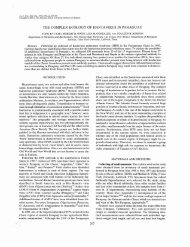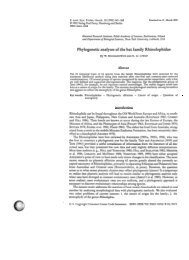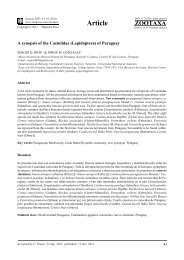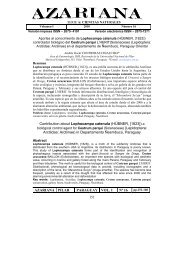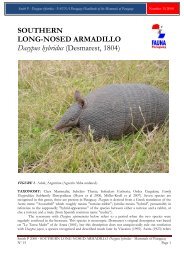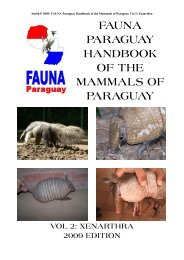Smith P 2012 - FAUNA Paraguay
Smith P 2012 - FAUNA Paraguay
Smith P 2012 - FAUNA Paraguay
You also want an ePaper? Increase the reach of your titles
YUMPU automatically turns print PDFs into web optimized ePapers that Google loves.
<strong>Smith</strong> P - Gracilinanus microtarsus - <strong>FAUNA</strong> <strong>Paraguay</strong> Handbook of the Mammals of <strong>Paraguay</strong> Number 42 <strong>2012</strong><br />
Diet in Captivity Individuals have been caught in Sherman traps baited with banana pulp, peanut<br />
butter and cod liver oil (Martins et al 2006b, 2006c).<br />
REPRODUCTIVE BIOLOGY: The species is partially semelparous and shows markedly seasonal<br />
breeding. Reproduction typically occurs once in a lifetime followed by death, resulting in discrete, virtually<br />
non-overlapping generations (Martins et al 2006b). Martins et al (2006b) noted a sharp decline in the<br />
numbers of males captured after the beginning of the breeding season, though the number of females<br />
captured remained constant. Males that were captured in the postmating period showed signs of<br />
deteriorating body condition such as fur loss on the rump and high parasite loads, states that are typically<br />
associated with low survival rates in marsupials. As a result the declining capture rate of males was<br />
attributed to postbreeding mortality. Of the males they marked and recaptured just 18% survived to the<br />
second breeding season. As a result the species was considered partially semelparous, with mortality sharp<br />
following the first breeding, but not complete. Passamani (2000) noted a slight bias in sex ratios male 1.4 :<br />
1 females.<br />
Seasonality Martins et al (2006a) documented the seasonality of breeding of this species in the<br />
cerrado of São Paulo State. They found reproductive females from September (end of the cool.dry season)<br />
to March (end of the warm.wet season). All females captured from September to December were in<br />
reproductive condition. One female was captured with a litter of 9 newborns attached to teats, and based<br />
on the number of functional nipples the mean litter size was estimated as 10.9 (+/-2.3, n=15).<br />
Passamani (2000) noted that 21 of 25 specimens captured in the wet season (>150mm per month)<br />
in Espírito Santo, Brazil showed signs of reproduction, whilst none of 31 those caught in drier seasons<br />
did. The breeding season is from October to March, with the first juveniles being caught in January. He<br />
detected a sex ratio of one female to every 1.4 males. Adult males have the testes permanently in the<br />
scrotum meaning that only the reproductive condition of females can be adequately assessed under field<br />
conditions (Martins et al 2006).<br />
Pregnancy Tubelis (2000) reported litter sizes of 8 to 12 in São Paulo State, with a mean of 9.67<br />
(n=9). Females give birth in a cavity containing a leaf nest, but all suckling females found in nest boxes<br />
had naked young, suggesting that they leave the nest soon after parturition.<br />
GENERAL BEHAVIOUR: Solitary and nocturnal (Pires et al 2008).<br />
Home Range Passamani (2000) calculated that females remained in his trapping area for a mean<br />
of 4.3 months and a maximum of 9 months, with a mean recapture rate of 4.8. Males remained in the<br />
trapping area for a mean of 2.3 months and only one individual was present for nine months, with the<br />
mean recapture rate for males of 3.3. These figures are consistent with the short life cycle of the species<br />
and hence probably not related to movements.<br />
Martins et al (2006a) calculated that the mean distance moved by individuals in their 1.24ha<br />
trapping grid was just 27m (+/-5.3). Monthly population estimates ranged from 8 to 29 individuals (mean<br />
14 individuals, +/-4.5). Population density peaked between December and March and remained at a high<br />
intermediate value until August, decreasing at the beginning of reproduction in September. Monthly<br />
population density estimates ranged from 6.5 to 23.4 individuals/hectare (mean 11.3 individual/hectare,<br />
+/.3.6).<br />
Fernandes et al (2010) noted a positive correlation between mass and greater size of home range.<br />
They noted that a male that did not change in mass (21g) between the warm-wet and cool-dry season did<br />
not show a change in home range size from 1350m 2 , whilst a male that increased from 16 to 22g between<br />
the two seasons also increased its home range size from 1800m 2 to 6300m 2 . A similar but less dramatic<br />
pattern was seen in females with the following increases in mass and home range observed in X<br />
individuals: 14-17g, 1463-1688m 2 ; 12-16g, 2363-2700m 2 ; 14-15g, 563-675m 2 . One female reversed the<br />
pattern 11-15g, 2587-900m 2 .<br />
Locomotion Delciellos & Vieira (2006) studied arboreal locomotion of this species on horizontal<br />
branches in PN Serra dos Orgãos, Rio de Janeiro State, Brazil. A maximum velocity of 16.68 (+/-3.19) x<br />
body length/second was recorded on support branches of 10.16cm diameter, and a minimum velocity of<br />
10.03 (+/-0.22) x body length/second was recorded on support branches of 2.54cm diameter. Minimum<br />
number of strides per second was 6.50 (+/-0.43) on a flat surface and maximum number of stride lengths<br />
<strong>Smith</strong> P <strong>2012</strong> - BRAZILIAN GRACILE OPOSSUM Gracilinanus microtarsus - Mammals of <strong>Paraguay</strong> Nº 42<br />
Page 7


